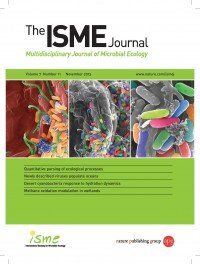
ISSN: 1751-7362
Journal Home
Journal Guideline
The ISME Journal Q1 Unclaimed
The ISME Journal is a journal indexed in SJR in Ecology, Evolution, Behavior and Systematics and Microbiology with an H index of 251. It has a price of 3060 €. It has an SJR impact factor of 3,973 and it has a best quartile of Q1. It is published in English. It has an SJR impact factor of 3,973.
The ISME Journal focuses its scope in these topics and keywords: globally, marine, microbial, niche, abundant, communities, community, deepsea, environmental, functional, ...
Type: Journal
Type of Copyright:
Languages: English
Open Access Policy: Open Choice
Type of publications:
Publication frecuency: -
3060 €
Inmediate OANPD
Embargoed OA0 €
Non OAMetrics
3,973
SJR Impact factor251
H Index283
Total Docs (Last Year)758
Total Docs (3 years)20576
Total Refs9316
Total Cites (3 years)746
Citable Docs (3 years)10.15
Cites/Doc (2 years)72.71
Ref/DocOther journals with similar parameters
Fungal Diversity Q1
Genome Biology Q1
Annual Review of Ecology, Evolution, and Systematics Q1
Trends in Ecology and Evolution Q1
Annual Review of Entomology Q1
Compare this journals
Aims and Scope
Best articles by citations
Structure and function of a cyanophage-encoded peptide deformylase
View moreGenomic reconstruction of multiple lineages of uncultured benthic archaea suggests distinct biogeochemical roles and ecological niches
View moreA virus or more in (nearly) every cell: ubiquitous networks of virus-host interactions in extreme environments
View moreCommunity genomic analysis of an extremely acidophilic sulfur-oxidizing biofilm
View moreThe unexpected discovery of a novel low-oxygen-activated locus for the anoxic persistence of Burkholderia cenocepacia
View moreA novel cohabitation between two diazotrophic cyanobacteria in the oligotrophic ocean
View moreGeographically structured host specificity is caused by the range expansions and host shifts of a symbiotic fungus
View moreQuantitative analysis of a deeply sequenced marine microbial metatranscriptome
View moreSalivary mucins promote the coexistence of competing oral bacterial species
View moreDiversity and distribution of single-stranded DNA phages in the North Atlantic Ocean
View moreDysbiosis of upper respiratory tract microbiota in elderly pneumonia patients
View moreDrivers of the composition of active rhizosphere bacterial communities in temperate grasslands
View moreProteorhodopsin light-enhanced growth linked to vitamin-B1 acquisition in marine Flavobacteria
View moreErratum: Culture and molecular-based profiles show shifts in bacterial communities of the upper respiratory tract that occur with age
View moreErratum: Dating the cyanobacterial ancestor of the chloroplast
View moreProductivity links morphology, symbiont specificity and bleaching in the evolution of Caribbean octocoral symbioses
View moreEcological roles of dominant and rare prokaryotes in acid mine drainage revealed by metagenomics and metatranscriptomics
View moreThe chemical interactome space between the human host and the genetically defined gut metabotypes
View moreUnderlying mechanisms for syntrophic metabolism of essential enzyme cofactors in microbial communities
View moreA dynamic microbial community with high functional redundancy inhabits the cold, oxic subseafloor aquifer
View moreDiversity and metabolism of Woeseiales bacteria, global members of marine sediment communities
View moreVibrio crassostreae, a benign oyster colonizer turned into a pathogen after plasmid acquisition
View moreLytic phages obscure the cost of antibiotic resistance in Escherichia coli
View moreMeta-omics uncover temporal regulation of pathways across oral microbiome genera during in vitro sugar metabolism
View more

Comments